new posts in all blogs
Viewing: Blog Posts Tagged with: middle grade poetry, Most Recent at Top [Help]
Results 1 - 9 of 9
How to use this Page
You are viewing the most recent posts tagged with the words: middle grade poetry in the JacketFlap blog reader. What is a tag? Think of a tag as a keyword or category label. Tags can both help you find posts on JacketFlap.com as well as provide an easy way for you to "remember" and classify posts for later recall. Try adding a tag yourself by clicking "Add a tag" below a post's header. Scroll down through the list of Recent Posts in the left column and click on a post title that sounds interesting. You can view all posts from a specific blog by clicking the Blog name in the right column, or you can click a 'More Posts from this Blog' link in any individual post.
 Fun Fact: The American Library Association does not currently give an award specifically to great works of children’s book poetry. Is not that strange? When I first discovered this to be true, I was perplexed. I’ve always been a bit of a rube when it comes to the poetic form. Placing stresses on syllables and knowing what constitutes a sestina and all that. Of course even without its own award specifically, poetry can win the Newbery or the Caldecott. Yet too often when it happens it’s in the form of a verse novel or its sort of pooh-poohed for its win. Remember when Last Stop on Market Street won the Newbery and folks were arguing that it was the first picture book to do so since A Visit to William’s Blake’s Inn couldn’t possibly be considered a picture book because it was poetry? None of this is to say that poetry doesn’t win Newberys (as recently as 2011 Dark Emperor and Other Poems of the Night by Joyce Sidman won an Honor) but aside from the month of April (Poetry Month a.k.a. the only time the 811 section of the public library is sucked dry) poetry doesn’t get a lot of attention.
Fun Fact: The American Library Association does not currently give an award specifically to great works of children’s book poetry. Is not that strange? When I first discovered this to be true, I was perplexed. I’ve always been a bit of a rube when it comes to the poetic form. Placing stresses on syllables and knowing what constitutes a sestina and all that. Of course even without its own award specifically, poetry can win the Newbery or the Caldecott. Yet too often when it happens it’s in the form of a verse novel or its sort of pooh-poohed for its win. Remember when Last Stop on Market Street won the Newbery and folks were arguing that it was the first picture book to do so since A Visit to William’s Blake’s Inn couldn’t possibly be considered a picture book because it was poetry? None of this is to say that poetry doesn’t win Newberys (as recently as 2011 Dark Emperor and Other Poems of the Night by Joyce Sidman won an Honor) but aside from the month of April (Poetry Month a.k.a. the only time the 811 section of the public library is sucked dry) poetry doesn’t get a lot of attention.
So rather than relegate all poetry discussions to April, let us today celebrate some of the lovelier works of poetry out for kids this year. Because we lucked out, folks. 2016 was a great year for verse:
2016 Poetry Books for Kids
Are You an Echo?: The Lost Poetry of Misuzu Kaneko by David Jacobson, ill. Toshikado Hajiri, translations by Sally Ito and Michiko Tsuboi
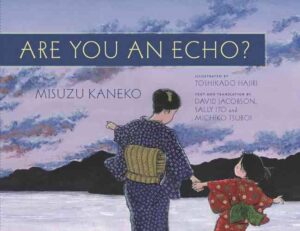
No surprises here. If you know me then you know I’m gaga for this title. For the purposes of today’s list, however, let’s just zero in on Kaneko’s own poetry. Cynical beast that I am, I would sooner eat my own tongue than use a tired phrase like “childlike wonder” to describe something. And yet . . . I’m stuck. Honestly there’s no other way to adequately convey to you what Kaneko has done so perfectly with this book. Come for the biography and history lesson. Stay for the incomparable poems.
Freedom Over Me: Eleven Slaves, Their Lives and Dreams Brought to Life by Ashley Bryan

I’m not entirely certain that I can express in words how deeply satisfying it’s been to see this book get as much love and attention as it has, so far. Already its appeared on Chicago Public Library’s Best of the Best, its been a Kirkus Prize Finalist, it was on the NCTE Notable Poetry List, and New York Public Library listed it on their Best Books for Kids. I would have liked to add an Image Award nomination in there as well, but you don’t always get what you want. Regardless, I maintain my position that this is a serious Newbery contender. Even if it misses out during the January award season, there is comfort in knowing that folks are finding it. Very satisfying.
Grumbles From the Town: Mother-Goose Voices With a Twist by Jane Yolen and Rebecca Kai Dotlich, ill. Angela Matteson

Its been promoted as a writing prompt book, but I’d argue that the poetry in this collection stands on its own two feet as well. Yolen and Dotlich take classic nursery rhymes and twist them. We’ve all seen that kind of thing before, but I like how they’ve twisted them. A passing familiarity with the original poetry a good idea, though they’ve covered their bases and included that information in the back of the book as well. Good original fun all around.
Jazz Day: The Making of a Famous Photograph by Roxane Orgill, ill. Francis Vallejo

So far it’s won the only major award (aside from the Kirkus prize) to be released so far for a 2016 title. Jazz Day took home the gold when it won in the picture book category of the Boston Globe-Horn Book Awards. And, granted, I was on that committee, but I wasn’t the only one there. It’s such an amazing book, and aside from poetry its hard to slot it into any one category. Fiction or nonfiction? You be the judge.
Miss Muffet, Or What Came After by Marilyn Singer, ill. David Litchfield

It’s sort of epic. From one single short little nursery rhyme, Singer spins out this grandiose tale of crushed hopes, impossible dreams, and overcoming arachnophobia. Since it’s a story told in rhyme I’m sort of cheating, putting it on this poetry list. Maybe it’s more school play than poetry book. I say, why not be both?
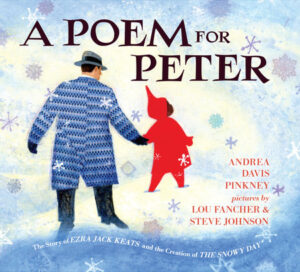
Now this book has been nominated for an NAACP Image Award, so there is some justice in this world. When I first read the description I wasn’t entirely certain how it would work. Imagine the daunting task of telling Ezra Jack Keats’ story using his own illustration style. Imagine too the difficulty that comes with using poetry and verse to tell the details of his story. Pinkney’s done poetry of one sort or another before, but I dare say this is her strongest work to date in that style.
Slickety Quick: Poems About Sharks by Skila Brown, ill. Bob Kolar
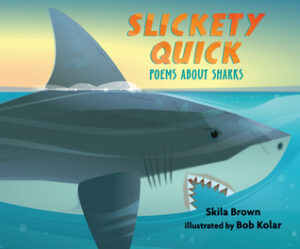
From the start I liked the poems (they were smart) but since it was about real sharks I pondered that question every children’s librarian knows so well: how would it fly with kids? Well, I donated a copy to my kid’s daycare and found, to my infinite delight, that the kids in that class were CRAZY about it. Every day when I went to pick my daughter up, she and the other kids would start telling me shark facts. You’ve gotta understand that these were four-year-olds telling me this stuff. If they get such a kick out of the book (and they do) imagine how the older kids might feel!
A Toucan Can, Can You? by Danny Adlerman, ill. Various
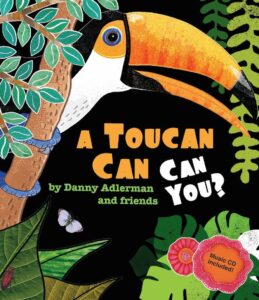
It’s baaaaack. Yeah, this little self-published gem keeps cropping up on my lists. Someone recently asked me where they could purchase it, since it’s not available through the usual streams. I think you can get it here, in case you’re curious. And why should you be curious? Because it takes that old How Much Wood Could a Woodchuck Chuck, expands it, and then gets seriously great illustrators to contribute. A lovely book.
Somo Como Las Nubes / We Are Like the Clouds by Jorge Argueta, ill. Elisa Amado
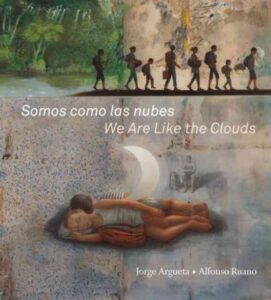
Because to be perfectly frank, your shelves aren’t exactly exploding with books about refugee children from South America. That said, it’s easy to include books on lists of this sort because their intentions are good. It’s another thing entirely when the book itself actually is good. Argueta is an old hand at this. You can trust him to do a fantastic job, and this book is simultaneously necessary and expertly done. There’s a reason I put it on my bilingual book list as well.
Spinach Dip Pancakes by Kevin Kammeraad, ill. Danny Adlerman, Kim Adlerman, Chris Fox, Alynn Guerra, Justin Haveman, Ryan Hipp, Stephanie Kammeraad, Carlos Kammeraad, Maria Kammeraad, Steve Kammeraad, Linda Kammeraad, Laurie Keller, Scott Mack, Ruth McNally Barshaw, Carolyn Stich, Joel Tanis, Corey Van Duinen, Aaron Zenz, & Rachel Zylstra
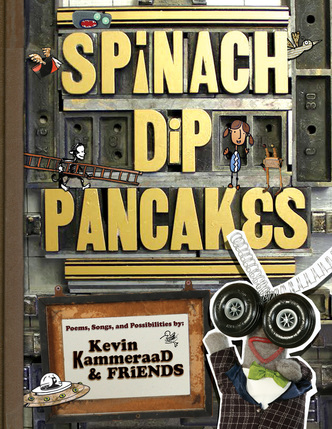
This book bears not a small number of similarities to the aforementioned Toucan Can book. The difference, however, is that these are all original little tiny poems put into a book illustrated by a huge range of different illustrators. The poems are funny and original and the art eclectic, weird, wise and wonderful. It even comes with a CD of performances of the poems. Want a taste? Then I am happy to premiere a video that is accompanying this book. The video cleverly brings to life the poem “Game”. I think you’ll get a kick out of it. And then be unable to remove it from your brain (good earworm, this).
If you liked that, check out the book’s book trailer and behind-the-scenes peek as well.
Wet Cement: A Mix of Concrete Poems by Bob Raczka
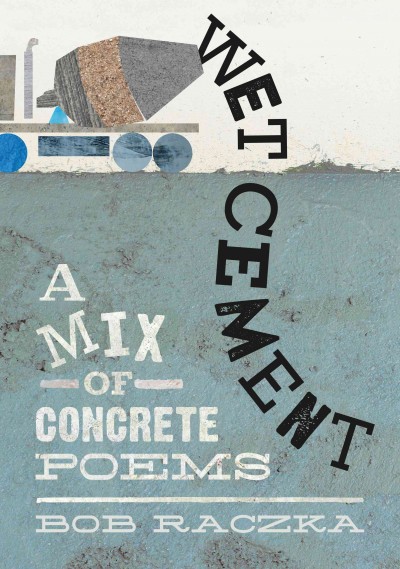
My year is not complete unless I am able to work a Raczka poetry collection onto a list. I’m very partial to this one. It’s a bit graphic design-y and a bit clever as all get out. Here’s my favorite poem of the lot:
Poetry is about taking away the words you don’t need
poetry is taking away words you don’t need
poetry is words you need
poetry is words
try
When Green Becomes Tomatoes: Poems for All Seasons by Julie Fogliano, ill. Julie Morstad

I think I broke more than a few hearts when I told people that Morstad’s Canadian status meant the book was ineligible for a Caldecott. At least you can take comfort in the fact that the poetry is sublime. I think we’ve all seen our fair share of seasonal poems. They’re not an original idea, yet Fogliano makes them seem new. This collection actually bears much in common with the poetry of the aforementioned Misuzu Kaneko. I think she would have liked it.
You Can Fly: The Tuskegee Airmen by Carole Boston Weatherford, ill. Jeffery Boston Weatherford
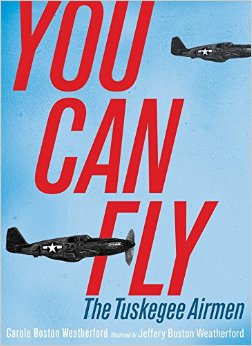
It’s poetry and a kind of verse novel as well. I figured I should include one in today’s list, though I’d argue that the verse here serves the poems better than the storyline. There is a storyline, of course, but I like the poetry for its own sake. My favorite in the book? The one about Lena Horne. I had no idea the personal sacrifices she made during WWII. There’s a picture book bio coming out about her in 2017, by the way. Looks like I’ll need to know more.
Interested in the other lists of the month? Here’s the schedule so that you can keep checking back:
December 1 – Board Books
December 2 – Board Book Adaptations
December 3 – Nursery Rhymes
December 4 – Picture Book Readalouds
December 5 – Rhyming Picture Books
December 6 – Alphabet Books
December 7 – Funny Picture Books
December 8 – Calde-Nots
December 9 – Picture Book Reprints
December 10 – Math Picture Books
December 11 – Bilingual Books
December 12 – International Imports
December 13 – Books with a Message
December 14 – Fabulous Photography
December 15 – Fairy Tales / Folktales
December 16 – Oddest Books of the Year
December 17 – Older Picture Books
December 18 – Easy Books
December 19 – Early Chapter Books
December 20 – Graphic Novels
December 21 – Poetry
December 22 – Fictionalized Nonfiction
December 23 – American History
December 24 – Science & Nature Books
December 25 – Transcendent Holiday Titles
December 26 – Unique Biographies
December 27 – Nonfiction Picture Books
December 28 – Nonfiction Chapter Books
December 29 – Novel Reprints
December 30 – Novels
December 31 – Picture Books


By:
Betsy Bird,
on 10/5/2016
Blog:
A Fuse #8 Production
(
Login to Add to MyJacketFlap)
JacketFlap tags:
Misuzu Kaneko,
Best Books of 2016,
2016 reviews,
Reviews 2016,
2016 poetry,
2016 picture book biographies,
David Jacobson,
Michiko Tsuboi,
Toshikado Hajiri,
Reviews,
poetry,
Best Books,
picture book biographies,
Sally Ito,
funny poetry,
middle grade poetry,
Add a tag
 Are You an Echo? The Lost Poetry of Misuzu Kaneko
Are You an Echo? The Lost Poetry of Misuzu Kaneko
Narrative and Translation by David Jacobson, Sally Ito, and Michiko Tsuboi
Illustrated by Toshikado Hajiri
Chin Music Press
$19.50
ISBN: 9781634059626
Ages 5 and up
On shelves now
Recently I was at a conference celebrating the creators of different kinds of children’s books. During one of the panel discussions an author of a picture book biography of Fannie Lou Hamer said that part of the mission of children’s book authors is to break down “the canonical boundaries of biography”. I knew what she meant. A cursory glance at any school library or public library’s children’s room will show that most biographies go to pretty familiar names. It’s easy to forget how much we need biographies of interesting, obscure people who have done great things. Fortunately, at this conference, I had an ace up my sleeve. I knew perfectly well that one such book has just been published here in the States and it’s a game changer. Are You an Echo? The Lost Poetry of Misuzu Kaneko isn’t your typical dry as dust retelling of a life. It crackles with energy, mystery, tragedy, and, ultimately, redemption. This book doesn’t just break down the boundaries of biography. It breaks down the boundaries placed on children’s poetry, art, and translation too. Smarter and more beautiful than it has any right to be, this book challenges a variety of different biography/poetry conventions. The fact that it’s fun to read as well is just gravy.
Part biography, part poetry collection, and part history, Are You an Echo? introduces readers to the life and work of celebrated Japanese poet Misuzu Kaneko. One day a man by the name of Setsuo Yazaki stumbled upon a poem called “Big Catch”. The poet’s seemingly effortless ability to empathize with the plight of fish inspired him to look into her other works. The problem? The only known book of her poems out there was caught in the conflagration following the firebombing of Tokyo during World War II. Still, Setsuo was determined and after sixteen years he located the poet’s younger brother who had her diaries, containing 512 of Misuzu’s poems. From this, Setsuo was able to piece together her life. Born in 1902, Misuzu Kaneko grew up in Senzaki in western Japan. She stayed in school at her mother’s insistence and worked in her mother’s bookstore. For fun she submitted some of her poems to a monthly magazine and shockingly every magazine she submitted them to accepted them. Yet all was not well for Misuzu. She had married poorly, contracted a disease from her unfaithful husband that caused her pain, and he had forced her to stop writing as well. Worst of all, when she threatened to leave he told her that their daughter’s custody would fall to him. Unable to see a way out of her problem, she ended her life at twenty-six, leaving her child in the care of her mother. Years passed, and the tsunami of 2011 took place. Misuzu’s poem “Are You an Echo?” was aired alongside public service announcements and it touched millions of people. Suddenly, Misuzu was the most famous children’s poet of Japan, giving people hope when they needed it. She will never be forgotten again. The book is spotted with ten poems throughout Misuzu’s story, and fifteen additional poems at the end.
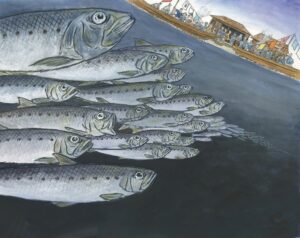 There’s been a lot of talk in the children’s literature sphere about the role of picture book biographies. More specifically, what’s their purpose? Are they there simply to inform and delight or do they need to actually attempt to encapsulate the great moments in a person’s life, warts and all? If a picture book bio only selects a single moment out of someone’s life as a kind of example, can you still call it a biography? If you make up dialogue and imagine what might have happened in one scene or another, do those fictional elements keep it from the “Biography” section of your library or bookstore, or is there a place out there for fictionalized bios? These questions are new ones, just as the very existence of picture book biographies, in as great a quantity as we’re seeing them, is also new. One of the takeaways I’ve gotten from these conversations is that it is possible to tackle difficult subjects in a picture book bio, but it must be done naturally and for a good reason. So a story like Gary Golio’s Spirit Seeker can discuss John Coltrane’s drug abuse, as long as it serves the story and the character’s growth. On the flip side, Javaka Steptoe’s Radiant Child, a biography of Basquiat, makes the choice of discussing the artist’s mother’s fight with depression and mental illness, but eschews any mention of his own suicide.
There’s been a lot of talk in the children’s literature sphere about the role of picture book biographies. More specifically, what’s their purpose? Are they there simply to inform and delight or do they need to actually attempt to encapsulate the great moments in a person’s life, warts and all? If a picture book bio only selects a single moment out of someone’s life as a kind of example, can you still call it a biography? If you make up dialogue and imagine what might have happened in one scene or another, do those fictional elements keep it from the “Biography” section of your library or bookstore, or is there a place out there for fictionalized bios? These questions are new ones, just as the very existence of picture book biographies, in as great a quantity as we’re seeing them, is also new. One of the takeaways I’ve gotten from these conversations is that it is possible to tackle difficult subjects in a picture book bio, but it must be done naturally and for a good reason. So a story like Gary Golio’s Spirit Seeker can discuss John Coltrane’s drug abuse, as long as it serves the story and the character’s growth. On the flip side, Javaka Steptoe’s Radiant Child, a biography of Basquiat, makes the choice of discussing the artist’s mother’s fight with depression and mental illness, but eschews any mention of his own suicide.
Are You An Echo? is an interesting book to mention alongside these two other biographies because the story is partly about Misuzu Kaneko’s life, partly about how she was discovered as a poet, and partly a highlight of her poetry. But what author David Jacobson has opted to do here is tell the full story of her life. As such, this is one of the rare picture book bios I’ve seen to talk about suicide, and probably the only book of its kind I’ve ever seen to make even a passing reference to STDs. Both issues informed Kaneko’s life, depression, feelings of helplessness, and they contribute to her story. The STD is presented obliquely so that parents can choose or not choose to explain it to kids if they like. The suicide is less avoidable, so it’s told in a matter-of-fact manner that I really appreciated. Euphemisms, for the most part, are avoided. The text reads, “She was weak from illness and determined not to let her husband take their child. So she decided to end her life. She was only twenty-six years old.” That’s bleak but it tells you what you need to know and is honest to its subject.
 But let’s just back up a second and acknowledge that this isn’t actually a picture book biography in the strictest sense of the term. Truthfully, this book is rife, RIFE, with poetry. As it turns out, it was the editorial decision to couple moments in Misuzu’s life with pertinent poems that gave the book its original feel. I’ve been wracking my brain, trying to come up with a picture book biography of a poet that has done anything similar. I know one must exist out there, but I was hard pressed to think of it. Maybe it’s done so rarely because the publishers are afraid of where the book might end up. Do you catalog this book as poetry or as biography? Heck, you could catalog it in the Japanese history section and still be right on in your assessment. It’s possible that a book that melds so many genres together could only have been published in the 21st century, when the influx of graphic inspired children’s literature has promulgated. Whatever the case, reading this book you’re struck with the strong conviction that the book is as good as it is precisely because of this melding of genres. To give up this aspect of the book would be to weaken it.
But let’s just back up a second and acknowledge that this isn’t actually a picture book biography in the strictest sense of the term. Truthfully, this book is rife, RIFE, with poetry. As it turns out, it was the editorial decision to couple moments in Misuzu’s life with pertinent poems that gave the book its original feel. I’ve been wracking my brain, trying to come up with a picture book biography of a poet that has done anything similar. I know one must exist out there, but I was hard pressed to think of it. Maybe it’s done so rarely because the publishers are afraid of where the book might end up. Do you catalog this book as poetry or as biography? Heck, you could catalog it in the Japanese history section and still be right on in your assessment. It’s possible that a book that melds so many genres together could only have been published in the 21st century, when the influx of graphic inspired children’s literature has promulgated. Whatever the case, reading this book you’re struck with the strong conviction that the book is as good as it is precisely because of this melding of genres. To give up this aspect of the book would be to weaken it.
Right off the bat I was impressed by the choice of poems. The first one you encounter is called “Big Catch” and it tells about a village that has caught a great number of fish. The poem ends by saying, “On the beach, it’s like a festival / but in the sea they will hold funerals / for the tens of thousands dead.” The researcher Setsuo Yazaki was impressed by the poet’s empathy for the fish, and that empathy is repeated again and again in her poems. “Big Catch” is actually one of her bleaker works. Generally speaking, the poems look at the world through childlike eyes. “Wonder” contemplates small mysteries, in “Beautiful Town” the subject realizes that a memory isn’t from life but from a picture in a borrowed book, and “Snow Pile” contemplates how the snow on the bottom, the snow on the top, and the snow in the middle of a pile must feel when they’re all pressed together. The temptation would be to call Kaneko the Japanese Emily Dickenson, owing to the nature of the discovery of her poems posthumously, but that’s unfair to both Kaneko and Dickenson. Kenko’s poems are remarkable not just because of their original empathy, but also because they are singularly childlike. A kid would get a kick out of reading these poems. That’s no mean feat.
 Mind you, we’re dealing with a translation here. And considering how beautifully these poems read, you might want a note from the translators talking about their process. You can imagine, then, how thrilled I was to find a half-page’s worth of a “Translators’ Note” explaining aspects of the work here that never would have occurred to me in a million years. The most interesting problem came down to culture. As Sally Ito and Michiko Tsuboi write, “In Japanese, girls have a particular way of speaking that is affectionate and endearing . . . However, English is limited in its capacity to convey Misuzu’s subtle feminine sensibility and the elegant nuances of her classical allusions. We therefore had to skillfully work our way through both languages, often producing several versions of a poem by discussing them on Skype and through extensive emails – Michiko from Japan, Sally from China – to arrive at the best possible translations in English.” It makes a reader really sit back and admire the sheer levels of dedication and hard work that go into a book of this sort. If you read this book and find that the poems strike you as singularly interesting and unique, you may now have to credit these dedicated translators as greatly as you do the original subject herself. We owe them a lot.
Mind you, we’re dealing with a translation here. And considering how beautifully these poems read, you might want a note from the translators talking about their process. You can imagine, then, how thrilled I was to find a half-page’s worth of a “Translators’ Note” explaining aspects of the work here that never would have occurred to me in a million years. The most interesting problem came down to culture. As Sally Ito and Michiko Tsuboi write, “In Japanese, girls have a particular way of speaking that is affectionate and endearing . . . However, English is limited in its capacity to convey Misuzu’s subtle feminine sensibility and the elegant nuances of her classical allusions. We therefore had to skillfully work our way through both languages, often producing several versions of a poem by discussing them on Skype and through extensive emails – Michiko from Japan, Sally from China – to arrive at the best possible translations in English.” It makes a reader really sit back and admire the sheer levels of dedication and hard work that go into a book of this sort. If you read this book and find that the poems strike you as singularly interesting and unique, you may now have to credit these dedicated translators as greatly as you do the original subject herself. We owe them a lot.
In the back of the book there is a note from the translators and a note from David Jacobson who wrote the text of the book that didn’t include the poetry. What’s conspicuously missing here is a note from the illustrator. That’s a real pity too since biographical information about artist Toshikado Hajiri is missing. Turns out, Toshikado is originally from Kyoto and now lives in Anan, Tokushima. Just a cursory glance at his art shows a mild manga influence. You can see it in the eyes of the characters and the ways in which Toshikado chooses to draw emotions. That said, this artist is capable of also conveying great and powerful moments of beauty in nature. The sunrise behind a beloved island, the crush of chaos following the tsunami, and a peach/coral/red sunset, with a grandmother and granddaughter silhouetted against its beauty. What Toshikado does here is match Misuzu’s poetry, note for note. The joyous moments she found in the world are conveyed visually, matching, if never exceeding or distracting from, her prowess. The end result is more moving than you might expect, particularly when he includes little human moments like Misuzu reading to her daughter on her lap or bathing her one last time.
Here is what I hope happens. I hope that someday soon, the name “Misuzu Kaneko” will become better known in the United States. I hope that we’ll start seeing collections of her poems here, illustrated by some of our top picture book artists. I hope that the fame that came to Kaneko after the 2011 tsunami will take place in America, without the aid of a national disaster. And I hope that every child that reads, or is read, one of her poems feels that little sense of empathy she conveyed so effortlessly in her life. I hope all of this, and I hope that people find this book. In many ways, this book is an example of what children’s poetry should strive to be. It tells the truth, but not the truth of adults attempting to impart wisdom upon their offspring. This is the truth that the children find on their own, but often do not bother to convey to the adults in their lives. Considering how much of this book concerns itself with being truthful about Misuzu’s own life and struggles, this conceit matches its subject matter to a tee. Beautiful, mesmerizing, necessary reading for one and all.
On shelves now.
Source: Final copy sent from publisher for review.
Like This? Then Try:
Misc: An article in PW about the translation.


By:
Betsy Bird,
on 8/6/2015
Blog:
A Fuse #8 Production
(
Login to Add to MyJacketFlap)
JacketFlap tags:
Reviews,
poetry,
Best Books,
Henry Holt and Company,
macmillan,
Calef Brown,
Christy Ottaviano Books,
funny poetry,
2010 poetry,
middle grade poetry,
Best Books of 2015,
Reviews 2015,
2015 poetry,
Add a tag
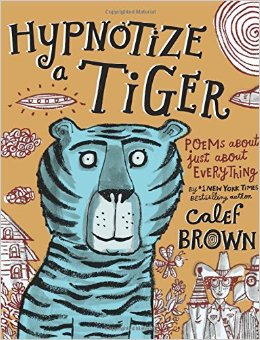 Hypnotize a Tiger: Poems About Just About Everything
Hypnotize a Tiger: Poems About Just About Everything
By Calef Brown
Christy Ottaviano Books, Henry Holt (an imprint of Macmillan)
$17.99
ISBN: 978-0-8050-9928-7
For ages 9-12
Why do I do this to myself? Let me tell you something about how I review. Board books? Pshaw. I can take one and write a nine-paragraph review parsing precisely why it is that Bizzy Bear’s preferred companions are dogs and bunnies. Nonfiction? Lay it on me. I’ll take infinite pleasure in discussing the difference between informational texts when I was a child (long story short, they sucked) and our current golden age. But there is one book genre that lays me flat. Stops me short. Makes it exceedingly difficult for me to get my head in order. Truly, children’s poetry books are the hardest to review. I don’t know exactly why this is. They are the most unloved of the books for kids. No American Library Association accredited awards are made specifically for them. They get checked out of libraries one month a year (April = National Poetry Month) and then lie forgotten. Yet so many of them are bite-sized wallops of greatness. Hypnotize a Tiger by Calef Brown is one of these chosen few. Not many poetry books for kids sport blurbs from Daniel Pinkwater (who found a soul mate in Brown’s art) to Jack Gantos to The Book of Life director Jorge R. Gutierrez. And few author/illustrators are allowed to go as positively wacky and wild as Brown does here. From tomato ultimatums and loofah tortes to velocipede odes and dodgebull (rather than dodgeball) you honestly never know where the book is going next. And you’re grateful for it.
So if it’s so great (and it is) why is reviewing a book of this sort the devil to do? There are any number of reasons. When reviewing a book with, say, a plot, it’s awfully easy for me to merely recap the plot, dish on the characters, bring up some single strange or scintillating point, then close it all down with a conclusion. Easy peasy. But poetry’s not really like that. There’s no plot to Hypnotize a Tiger. There’s not even a running gag that keeps cropping up throughout the pages. Each poem is its own little world. As a result, I’m stuck generalizing about the poems as a whole. And because we are dealing with 84-85 (depending on how you count) of them in total, I’m probably going to end up saying something about how some of the poems work and others don’t. This is kind of a cheat when you’re reviewing a collection of this sort because almost no children’s poetry book is absolutely perfect (Example A: The fact that Shel Silverstein wrote “Hug-a-War” . . . I rest my case). They will always consist of some verses that work and others that do not. In the end, the best I can hope for when reviewing poetry is to try to find something that makes it different from all the other poetry books published in a given year. Fortunately for me, Mr. Brown is consistently interesting. As Pinkwater said in his blurb, “He is a bulwark against mediocrity.”
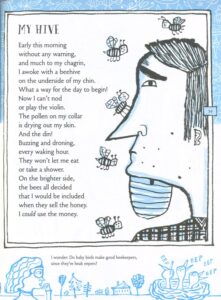 I’m very interested in the question of how to get kids around to reading poetry. My own daughter is four at this time and we’ve found that Shel Silverstein’s poetry books make for good bedtime reading (though she’s still thrown off by the occasional grotesquerie). For many children, Silverstein is the gateway drug. But Calef Brown, though he swims in Shel’s surrealism soaked seas, is a different breed entirely from his predecessor. Where Shel went for the easy silly ideas, Brown layers his ridiculousness with a bit of sophistication. Anyone could write a poem about waking up to find a beehive attached to the underside of their chin. It takes a Calef Brown to go one step further and have the unfortunate soul consider the monetary implications. Or to consider the verbal capabilities of Hoboken-based gnomes. So Hypnotize a Tiger becomes a book meant for the kid with a bit of prior poetry knowledge under their belt. You wouldn’t hand this title to a reluctant reader. You’d give it to the kid who’d already devoured all the Silverstein and Prelutsky and came to you asking, “What else you got?” That kid might be ready.
I’m very interested in the question of how to get kids around to reading poetry. My own daughter is four at this time and we’ve found that Shel Silverstein’s poetry books make for good bedtime reading (though she’s still thrown off by the occasional grotesquerie). For many children, Silverstein is the gateway drug. But Calef Brown, though he swims in Shel’s surrealism soaked seas, is a different breed entirely from his predecessor. Where Shel went for the easy silly ideas, Brown layers his ridiculousness with a bit of sophistication. Anyone could write a poem about waking up to find a beehive attached to the underside of their chin. It takes a Calef Brown to go one step further and have the unfortunate soul consider the monetary implications. Or to consider the verbal capabilities of Hoboken-based gnomes. So Hypnotize a Tiger becomes a book meant for the kid with a bit of prior poetry knowledge under their belt. You wouldn’t hand this title to a reluctant reader. You’d give it to the kid who’d already devoured all the Silverstein and Prelutsky and came to you asking, “What else you got?” That kid might be ready.
It is useful to note that you need to read this book aloud as well. There should be a warning sticker on the cover that says as much. Not that Brown makes it easy for you. Take the poem “Hugh”, for example. Short and simple it reads, “Meet my Belgian friend / He lives near Bruges, on a farm. / His name is Hugh Jarm.” Then at the bottom one of the tiny interstitial poems reads, “I once had a dream I was visiting Bruges – / snacking on chocolates while riding a luge.” Now the correct pronunciation of “Bruges” isn’t really necessary in the first poem, though it helps. The little tiny poem, however, is interesting because while it works especially well when you pronounce it correctly, you could probably mangle the wordplay easy peasy and still end up with a successful poem. SLJ probably said it best when they mentioned in their review of the book that, “Though there is more than one line that does not roll easily off the tongue and awkward rhymes abound, it is easy to see this clumsiness as part of the spirit of the collection.”
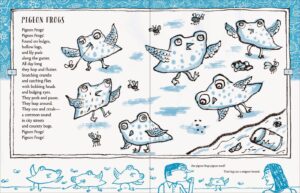 The subtitle of the collection is “Poems About Just About Everything” and that’s a fairly accurate representation. It does not mean, however, that there isn’t an internal logic to what’s being included here. There’s a chapter of animal poems, of people, insects, vehicles, schools, food, and then more esoteric descriptions like “Facts Poetic”, “Word Crashes”, and “Miscellaneous Silliness.” No poem directly applies to another, but they still manage to work together in tandem fairly well.
The subtitle of the collection is “Poems About Just About Everything” and that’s a fairly accurate representation. It does not mean, however, that there isn’t an internal logic to what’s being included here. There’s a chapter of animal poems, of people, insects, vehicles, schools, food, and then more esoteric descriptions like “Facts Poetic”, “Word Crashes”, and “Miscellaneous Silliness.” No poem directly applies to another, but they still manage to work together in tandem fairly well.
I don’t think it’s a serious criticism of a book to say that it’s not for all audiences. Calef Brown is an acquired taste. A taste best suited to the cleverest of the youngsters, absolutely, but acquired just the same. Not everyone is drawn to his style, and more fool they. To my mind, there is room enough in this world for any Calef Brown collection you can name. This book doesn’t have the widely popular feel of, say, a We Go Together but nor is the author writing poems simply to hear himself speak. Hypnotize a Tiger is a book built to please fans of creative curated silliness. Don’t know if you’ll like it? There’s only one way to find out. Pick this puppy up and read it to a kid. The book may surprise you (and so might the kid!).
On shelves now.
Source: Final copy sent from publisher for review.
Like This? Then Try:
Misc:
- I think this may honestly constitute the greatest class visit of all time.


By:
Betsy Bird,
on 10/30/2013
Blog:
A Fuse #8 Production
(
Login to Add to MyJacketFlap)
JacketFlap tags:
Reviews,
poetry,
Chronicle,
John Parra,
J. Patrick Lewis,
R. Gregory Christie,
Meilo So,
middle grade historical fiction,
Jim Burke,
middle grade poetry,
Reviews 2013,
2013 reviews,
2013 poetry,
Tonya Engel,
Add a tag
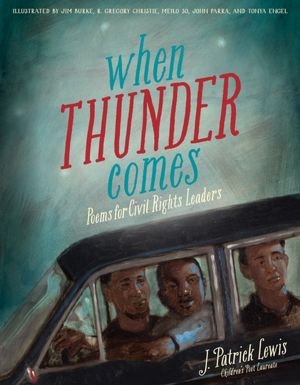 When Thunder Comes: Poems for Civil Rights Leaders
When Thunder Comes: Poems for Civil Rights Leaders
By J. Patrick Lewis
Illustrated by Jim Burke, R. Gregory Christie, Tonya Engel, John Parra, and Meilo So
Chronicle Books
$16.99
ISBN: 978-1-4521-0119-4
Ages 10 and up
On shelves now
Poetry is of the people by its very definition. Though sometimes considered the property of the elite (usually by folks who were forced to eat poetry unfiltered in high school by bored teachers) at its best it is a format that any human with a sense of rhythm and/or timing can use to their advantage. Poetry is the voice of people who are oppressed. When Chinese immigrants found themselves detained for weeks on end on Angel Island, they scratched poetry into the very walls of the building. Not curses. Not cries. Poems. It seems fitting then that J. Patrick Lewis should cull together poems to best celebrate “civil rights leaders” both known and unknown. People of different races, creeds, religions, and even sexualities are celebrated in a book that can only be honestly called what it is: one-of-a-kind.
Seventeen people. That doesn’t sound like a lot of folks. Seventeen people turning the tide of history and oppression. Seventeen individuals who made a difference and continue to make a difference every day. And to accompany them, seventeen poems by a former Children’s Poet Laureate. In When Thunder Comes, J. Patrick Lewis highlights heroes of every stripe. And, in doing so, lets young readers know what a hero truly is.
 Lewis isn’t phoning this one in. These poems are straight up honest-to-god works of poetry. Though the book is a mere 44 pages or so, its picture book size is misleading indeed. Consider this poem about Aung San Suu Kyi containing the following lines: “When a cyclone flicked off the roof of my prison / like the Queen of Hearts, turning my life to shame / and candle, the General had a mole removed. / When they added four words to the constitution – / my name – to bar me from ever running for office, / the General signed it with his fingernail made of / diamonds and disgust.” We’re on beyond nursery rhymes and patter here. There are also individual lines you just can’t help but admire. I like this one about Nelson Mandela in particular: “It is as if he’s landed on the moon / Five years before the actual event.”
Lewis isn’t phoning this one in. These poems are straight up honest-to-god works of poetry. Though the book is a mere 44 pages or so, its picture book size is misleading indeed. Consider this poem about Aung San Suu Kyi containing the following lines: “When a cyclone flicked off the roof of my prison / like the Queen of Hearts, turning my life to shame / and candle, the General had a mole removed. / When they added four words to the constitution – / my name – to bar me from ever running for office, / the General signed it with his fingernail made of / diamonds and disgust.” We’re on beyond nursery rhymes and patter here. There are also individual lines you just can’t help but admire. I like this one about Nelson Mandela in particular: “It is as if he’s landed on the moon / Five years before the actual event.”
The content is noticeably more mature as well. Kids have plenty of books to choose between when it comes to the Freedom Riders and Walkers, but the deaths of James Chaney, Andrew Goodman, and Michael Schwerner are dark as dark can be. That poem is told, not in broken up sections, but as a single long, square paragraph. Other ideas, like Muhammad Yunus and his microcredit system or Harvey Milk and his fight for gay rights require a bit more worldly knowledge on the part of readers.
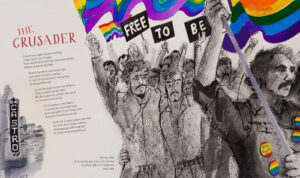 Lewis makes some interesting choices along the way. He’s careful to include familiar names (Gandhi, Nelson Mandela, Jackie Robinson, etc.) alongside lesser-known figures (Aung San Suu Kyi, Helen Zia, Ellison Onizuka, etc.). Some are living, some long dead. Each person has a title (“activist”, “auntie”, etc.). For “the innocent” he names Mamie Carthan Till but not her son, Emmett. At first I was confused by the choice, but the end matter made it clear that it was Mrs. Till that insisted that her son’s funeral be an open casket affair. An act of rebellion in and of itself. And this is undoubtedly the first book for children I’ve read that made special note of Harvey Milk. I know that some smaller presses have highlighted him in the past, but it’s particularly satisfying in this day and age to see him properly named and credited. A sign of the times, if you will.
Lewis makes some interesting choices along the way. He’s careful to include familiar names (Gandhi, Nelson Mandela, Jackie Robinson, etc.) alongside lesser-known figures (Aung San Suu Kyi, Helen Zia, Ellison Onizuka, etc.). Some are living, some long dead. Each person has a title (“activist”, “auntie”, etc.). For “the innocent” he names Mamie Carthan Till but not her son, Emmett. At first I was confused by the choice, but the end matter made it clear that it was Mrs. Till that insisted that her son’s funeral be an open casket affair. An act of rebellion in and of itself. And this is undoubtedly the first book for children I’ve read that made special note of Harvey Milk. I know that some smaller presses have highlighted him in the past, but it’s particularly satisfying in this day and age to see him properly named and credited. A sign of the times, if you will.
Another thing I like about the book is its ability to highlight individuals that should be, and are not, household names. If Sylvia Mendez truly paved the way for Brown v. Board of Education, why isn’t Mendez v. Westminster better known? Certainly the book is ideal for writing assignments. The poems vary in terms of style, and I can see teachers everywhere assigning even more too little lauded heroes to their students, asking them to cultivate poems of their own. It would have been nice if somewhere in the book it said what the types of poems featured were (villanelles don’t come along in children’s books every day, after all). Teachers hoping to make connections between some of the subjects then and now might also point out things like how Emmett Till bought candy prior to his death, not unlike a more contemporary hoodied young man.
 Of the various objections I’ve heard leveled against this book, there is the problem that each piece of art is not directly credited to its artist. Meilo So’s style is recognizable enough. Ditto R. Gregory Christie. But who did that image of Josh Gibson? Or Dennis James Banks for that matter? Now, the artists are listed on the publication page with references to their images, but since the book itself isn’t paginated this isn’t as useful as it might be. And some of the images work better than others, of course. While I wasn’t as taken with the images of Coretta Scott King, Mamie Carthan Till, or Dennis James Banks, I really liked Josh Gibson wearing his “Grays” garb, standing against a sky full of clouds. A different librarian objected to the fact that the three men murdered by the Klan in 1964 are featured with very similar, dark skin tones. I see the point, but since the shot is taken at night and the whole of the image is itself dark, this didn’t worry me as much.
Of the various objections I’ve heard leveled against this book, there is the problem that each piece of art is not directly credited to its artist. Meilo So’s style is recognizable enough. Ditto R. Gregory Christie. But who did that image of Josh Gibson? Or Dennis James Banks for that matter? Now, the artists are listed on the publication page with references to their images, but since the book itself isn’t paginated this isn’t as useful as it might be. And some of the images work better than others, of course. While I wasn’t as taken with the images of Coretta Scott King, Mamie Carthan Till, or Dennis James Banks, I really liked Josh Gibson wearing his “Grays” garb, standing against a sky full of clouds. A different librarian objected to the fact that the three men murdered by the Klan in 1964 are featured with very similar, dark skin tones. I see the point, but since the shot is taken at night and the whole of the image is itself dark, this didn’t worry me as much.
In many ways the book most similar to this is Marilyn Singer’s recent Rutherford B., Who Was He?: Poems About Our Presidents Like Singer’s book, Lewis presents the poems and people first and then provides an explanation of who they were at the end. Both give new slants on old names. But for all that, Lewis’s book is unique. Maybe not 100% perfect, but chock full of better poetry than you’ll find in a lot of children’s rooms, highlighting folks that deserve a little additional attention. Certainly bound to be of use to teachers, parents, and kids with an eye towards honest-to-goodness heroism. A lovely addition, no matter where you might be.
On shelves now.
Source: Reviewed from library copy.
Like This? Then Try:







By:
Betsy Bird,
on 5/7/2013
Blog:
A Fuse #8 Production
(
Login to Add to MyJacketFlap)
JacketFlap tags:
Wordsong,
Nancy Bo Flood,
middle grade poetry,
Reviews 2013,
2013 nonfiction,
2013 reviews,
2013 poetry,
Jan Sonnenmair,
Reviews,
poetry,
nonfiction,
Highlights,
nonfiction middle grade,
Add a tag
 Cowboy Up!: Ride the Navajo Rodeo
Cowboy Up!: Ride the Navajo Rodeo
By Nancy Bo Flood
Photography by Jan Sonnenmair
Wordsong (an imprint of Highlights)
$17.95
ISBN: 978-1-59078-893-6
Ages 8-12
On shelves now
Sometimes I think half my job simply consists of making lists. Not that I’m complaining. I love lists. I love making them, and checking them, and adding to them. Lists let the organizational part of my frontal lobe feel needed and wanted. Still, once in a while you get stuck on a list and it’s hard to move. For example, just the other day I was asked to come up with a list for Kindergartners of books that talk about Native American tribes. Some of the books, I was told, would also have to talk about American Indians living today. Now I don’t know anything about you. I don’t know if reading this review you’re a teacher or a librarian or an interested parent or my mom. Whosoever you might be, you are still probably very aware that asking for nonfiction titles for very young children on Native Americans is akin to asking for the moon and the stars above. Half the stuff on library and bookstore shelves is woefully out-of-date and offensive while the other half is written for kids ten-years-old and up. The pickings for small fry are slim. Enter Cowboy Up! Ride the Navajo Rodeo. The rare book that is both poetry and fact, with content for both big and little, here we have a title that finally fills that gap. Best of all, you don’t have to be looking for school or specialty fare to enjoy this one. Like wild bucking stallions and bulls that could impale you without so much as a snort? Welcome to the world of Navajo rodeo.
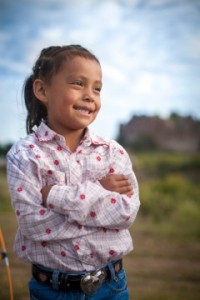 “Can’t sleep. Can’t eat. Mind keeps figuring, figuring, figuring – how tight to hold, how far to lean, how hard to squeeze to stay on top.” That’s just a sample of the thoughts going through a person’s head before the Navajo rodeo. Though it has its roots in places like Arizona and Texas, rodeos can be found all over the Navajo Nation and are family affairs. Setting her book during the course of a single rodeo day, author Nancy Bo Flood plunges readers into what might be an unknown world. We see children near bucked from woolly riders (sheep), adults flung from broncos, women who sweep the barrel racer events, steer wrestlers, and, best of all, bareback bull riders. Saturating her text with facts, background information, and tons of photographs, this is one title that will prove tempting to kids already familiar with the rodeo world and those approaching it for the very first time.
“Can’t sleep. Can’t eat. Mind keeps figuring, figuring, figuring – how tight to hold, how far to lean, how hard to squeeze to stay on top.” That’s just a sample of the thoughts going through a person’s head before the Navajo rodeo. Though it has its roots in places like Arizona and Texas, rodeos can be found all over the Navajo Nation and are family affairs. Setting her book during the course of a single rodeo day, author Nancy Bo Flood plunges readers into what might be an unknown world. We see children near bucked from woolly riders (sheep), adults flung from broncos, women who sweep the barrel racer events, steer wrestlers, and, best of all, bareback bull riders. Saturating her text with facts, background information, and tons of photographs, this is one title that will prove tempting to kids already familiar with the rodeo world and those approaching it for the very first time.
It’s a challenge facing any work of standard nonfiction for kids: How do you prefer to present your material? In this particular case, Ms. Flood has a wealth of information at her fingertips regarding the Navajo rodeo circuit. Trouble is, you can fill your book to brimming with the brightest and shiniest photos that money can buy, but if you’ve long blocks of nonfiction text you might lose your readership before you’ve even begun. Now in this book Ms. Flood presents her material over the course of a single rodeo day. It’s a good format for what she has to say, but the downside is that there are sections at the beginning that aren’t all that thrilling. If kids are coming to this book to see some high-flying riders, they’ll have to first wade through explanations about the announcer and the arena. That’s where the poetry comes in. Sure, there are big blocks of explanatory text before the action begins, but Flood tempers each two-page spread with not just photos and explanations but also poems. The advantage then is that younger children can read the poems while older ones get something out of the nonfiction sections. Win win!
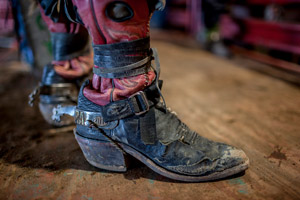 It sounds strange to say but in many ways the book that to me feels the closest to the format of Cowboy Up! is Good Masters! Sweet Ladies!: Voices from a Medieval Village by Laura Amy Schlitz. Both books find that the best way to get kids to swallow a spoonful of nonfiction is with a bit of first person narration. With that in mind, the poems in Cowboy Up! offer great promise. Each one is written in the first person and could easily be considered short monologues. The small child auditioning or the teacher who wants to do a theatrical presentation with readily available material would do well to take these poems and use them freely. Now granted, the poetry can be touch-and-go at times. I’ve a friend who personally cannot stand free verse in children’s books because to her it just looks like the author took a paragraph and broke it up into arbitrary lines. I happen to like free verse, insofar as I like any poetry, but I admit that the ones found here varied widely in terms of quality on a case-by-case basis.
It sounds strange to say but in many ways the book that to me feels the closest to the format of Cowboy Up! is Good Masters! Sweet Ladies!: Voices from a Medieval Village by Laura Amy Schlitz. Both books find that the best way to get kids to swallow a spoonful of nonfiction is with a bit of first person narration. With that in mind, the poems in Cowboy Up! offer great promise. Each one is written in the first person and could easily be considered short monologues. The small child auditioning or the teacher who wants to do a theatrical presentation with readily available material would do well to take these poems and use them freely. Now granted, the poetry can be touch-and-go at times. I’ve a friend who personally cannot stand free verse in children’s books because to her it just looks like the author took a paragraph and broke it up into arbitrary lines. I happen to like free verse, insofar as I like any poetry, but I admit that the ones found here varied widely in terms of quality on a case-by-case basis.
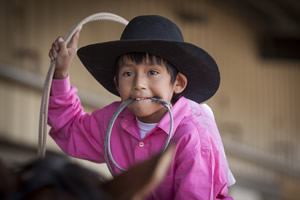 Much like the poetry, the photography in this book can vary. Some of the shots (created by photographer Jan Sonnenmair) are brilliant. I’m quite fond of the image on the jacket as well as shots of riders mid-air (one hand waving freely about their heads), the portraits (love those endpapers, though the decision to flips the images was a poor one when you consider library processing techniques), and even one of a rainbow rising behind the honor guard. On the other hand, there are times when it feels as though the book ran out of the good photographs and had to rely on some of the lesser variety. For example, there’s a shot of an announcer that looks like it appears twice in two pages, only flipped. This is a rare occurrence, but it happens early enough in the book that a reader could be forgiven for wondering if more duplication is bound to happen.
Much like the poetry, the photography in this book can vary. Some of the shots (created by photographer Jan Sonnenmair) are brilliant. I’m quite fond of the image on the jacket as well as shots of riders mid-air (one hand waving freely about their heads), the portraits (love those endpapers, though the decision to flips the images was a poor one when you consider library processing techniques), and even one of a rainbow rising behind the honor guard. On the other hand, there are times when it feels as though the book ran out of the good photographs and had to rely on some of the lesser variety. For example, there’s a shot of an announcer that looks like it appears twice in two pages, only flipped. This is a rare occurrence, but it happens early enough in the book that a reader could be forgiven for wondering if more duplication is bound to happen.
When I think of books that talk about contemporary Native Americans today, the pickings for kids are slim. The Absolutely True Diary of a Part-Time Indian isn’t exactly meant for the 12 and under crowd. Walking on Earth and Touching the Sky is pretty good, if a bit poetic (this might have something to do with the fact that it’s a book of poetry). And the book Native Americans: A Visual Exploration by S.N. Paleja covers a lot of ground, but only in brief. No, the whole reason Cowboy Up! even works is because it’s not trying to be about anything but how particularly cool this kind of rodeo is. This is Navajo life in the 21st century. So forget depressing texts that cover the past with all the interest of a phone book. Flood and Sonnenmair have culled together a look at the just-as-interesting present, and given it a format that will stand it in good stead. Cowboys and cowboys-to-be everywhere, stand up and rejoice. Your rodeo is here.
On shelves now.
Source: Final copy sent from publisher for review.
Like This? Then Try:
Professional Reviews: Kirkus
Interviews: ReaderKidz
Misc:
- A lesson hard learned. When searching for this book on any online site, I advise you to search via the ISBN 978-1-59078-893-6 rather than typing in the words “Cowboy Up”. Let’s just say that the bulk of titles you’ll find with the same title are a bit . . . ah . . . saucy.
- Download a free activity guide here.






 National Geographic Book of Animal Poetry: 200 Poems with Photographs That Squeak, Soar, and Roar!
National Geographic Book of Animal Poetry: 200 Poems with Photographs That Squeak, Soar, and Roar!
Edited by J. Patrick Lewis
National Geographic
$24.95
ISBN: 978-1-4263-1009-6
Ages 7-12
On shelves now
Animals make for good poetry. That’s just common sense. When humans get misty eyed and start thinking their great grand thoughts, they tend to be inspired by some form of nature. Naturally, some animals in particular are replete with awe-inspiring tendencies. Bald eagles, say. So where does that put your average hamster or flamingo? Not all animals are built to accompany great grand thoughts after all. Some of them are best suited to small, sly, clever verses instead. Taken as a whole, there are probably more animal poems in the world than a person could imagine. That’s why it’s rather clever of J. Patrick Lewis to pair with National Geographic’s talented photography department to bring us a gorgeously designed book of animal poems. You name the animal, the man has found (or perhaps solicited?) a poem to fit. Containing everything from limericks to haiku, this collection of two hundred poems and who knows how many photos is a visual feast for eye and ear alike.
“If you listen very carefully, you’ll hear the chicken hatching,” reads the first poem in this book. It’s “The Egg” by Jack Prelutsky and it starts off National Geographic Book of Animal Poetry’s “Welcome to the World” section. Split into eight different sections, the book categorizes its contents not by genus or species but by only the grandest of terms. There are “the big ones”, “the little ones”, “the winged ones”, “the water ones”, “the strange ones”, “the noisy ones”, and “the quiet ones”. Each poem is accompanied by a photograph, and sometimes the photograph is accompanied by more than one poem. There are verses poignant and funny, thought provoking and wild. Finally, at the end of the book, there is a section on “writing poems about animals” that aids kids by giving them a range of different forms to try. This is followed by a two-page spread of resources and four indexes at the end, one by title, one by poet, one by first line, and one by subject.
 What is unclear to me is the ratio of poems Lewis knew about and found verses the poems he went out and asked for. I noticed quite a few contemporary children’s poets between these pages. Janet S. Wong, Jane Yolen, Tracie Vaughn Zimmer, Michael J. Rosen, Bobbi Katz, Betsy Franco, etc. And I could not help but notice that those contemporary poets tended to write for some of the more difficult animals. The anemone, the blue jay, or the raccoon, for example. Here’s another question for you: Which came first, the photograph or the poem? Did Mr. Lewis plow through untold hundreds of National Geographic photos, old and new, cull the best and then find the poems, or did he find the poems first and then match the photos to fit? Certainly some of the National Geographic’s better known images are in this book (the picture of the flamingoes standing in the shape of a flamingo, for example). Sadly no note exists in this book telling us what Mr. Lewis’s process was.
What is unclear to me is the ratio of poems Lewis knew about and found verses the poems he went out and asked for. I noticed quite a few contemporary children’s poets between these pages. Janet S. Wong, Jane Yolen, Tracie Vaughn Zimmer, Michael J. Rosen, Bobbi Katz, Betsy Franco, etc. And I could not help but notice that those contemporary poets tended to write for some of the more difficult animals. The anemone, the blue jay, or the raccoon, for example. Here’s another question for you: Which came first, the photograph or the poem? Did Mr. Lewis plow through untold hundreds of National Geographic photos, old and new, cull the best and then find the poems, or did he find the poems first and then match the photos to fit? Certainly some of the National Geographic’s better known images are in this book (the picture of the flamingoes standing in the shape of a flamingo, for example). Sadly no note exists in this book telling us what Mr. Lewis’s process was.
There is a form to the chapters of this book but not so much form within the chapters. You might wonder at this at first, but since it’s easy enough to locate your favorite critter by using the subject index at the end of the book, it’s understandable why you might want to take the advice Mr. J. Patrick Lewis proffers at the beginning of the collection and know that “This book is not for reading straight through.” You dip in and find old favorites and new with ease. One librarian commented to me her surprise that the tiger poem in this book wasn’t William Blake’s “The Tyger”. True enough, but the anonymous poem with its classic limerick about the lady from Niger is rather well known within its own right. I was also amused in a very fifth grade boy kind of way by Michael J. Rosen’s blue-footed booby poem. You’ll have to see it for yourself to understand why.
 There are a couple times when the poem paired to the photo is a bit misleading or confusing. For example, for the picture of a butterfly still within its chrysalis, the poem is instead about a cocoon. I suppose cocoons are significantly less impressive photography-wise than chrysalises, but I’ve little doubt that kids will find the terms interchangeable now. Similarly there’s a poem about a sea horse that is inexplicably paired with an impressive but very different image of a weedy sea dragon. Credit where credit is due, each photograph is accompanied by a very small written description of its subject matter, but nine times out of ten the child reader will be relying on the poem to explain what they’re seeing. Probably because nine times out of ten that would be the right move.
There are a couple times when the poem paired to the photo is a bit misleading or confusing. For example, for the picture of a butterfly still within its chrysalis, the poem is instead about a cocoon. I suppose cocoons are significantly less impressive photography-wise than chrysalises, but I’ve little doubt that kids will find the terms interchangeable now. Similarly there’s a poem about a sea horse that is inexplicably paired with an impressive but very different image of a weedy sea dragon. Credit where credit is due, each photograph is accompanied by a very small written description of its subject matter, but nine times out of ten the child reader will be relying on the poem to explain what they’re seeing. Probably because nine times out of ten that would be the right move.
I can only imagine the sheer amounts of blood, sweat and tears that went into the collection and design of the book itself. It has its little quirks here and there, but if you’re seeking a poetry book for kids that children would willingly pick up and flip through, even if they have hitherto professed to not like poetry in the slightest, this is your best bet. A gorgeous little number that has the occasional slip-up, it is nonetheless a magnificent collection and book that is well worth the space it takes up. Add a little natural wonder to your poetry shelves. Because if we’re talking about the best possible compliment to your eyes and ears alike, few have as many perks and grand moments as this.
On shelves now.
Source: Final copy sent from publisher for review.
Like This? Then Try:
Other Blog Reviews:
Professional Reviews:
Videos:
Be sure to watch J. Patrick Lewis reading the poem “Make the Earth Your Companion here:

By:
Betsy Bird,
on 5/3/2012
Blog:
A Fuse #8 Production
(
Login to Add to MyJacketFlap)
JacketFlap tags:
Uncategorized,
poetry,
Susan Katz,
Robert Neubecker,
Houghton Mifflin Harcourt,
Clarion Books,
middle grade poetry,
2012 reviews,
2012 poetry,
Add a tag
 The President’s Stuck in the Bathtub!: Poems About the Presidents
The President’s Stuck in the Bathtub!: Poems About the Presidents
By Susan Katz
Illustrated by Robert Neubecker
Clarion Books (an imprint of Houghton Mifflin Harcourt)
$17.99
ISBN: 978-0-547-18221-6
Ages 6-10
On shelves now
Funny what kids pick up. When I was a tot of four I had a little electronic game that came with its own book. You’d turn the pages and press the button that corresponded to the correct trivia question. In this way I learned that Mozart wrote his first piece of music when he was five (I figured I had some leeway because of this), that Marie Antoinette had her head cut off, and that President Taft got stuck in his bathtub because he was so fat. That’s the kind of presidential wisdom a kid’s gonna carry with them the rest of their life. It’s also how I learned that teaching kids about famous people at a young age actually will stick with them into adulthood if the medium is interesting enough. Poetry would not be my first method of instilling memories, but in The President’s Stuck in the Bathtub!: Poems About the Presidents poet Susan Katz does a darn good job locating fun facts about even the dullest leaders. They may not have been equal in stature but at least in this book each one has his say, whether it’s escaping a vicious rabbit or seeing the occasional ghost.
They’ve been dull and scintillating. Clever and thick. Remarkably tall and surprisingly short. And what’s with all the parrots as pets? With great dexterity and even greater patience Susan Katz culls, entices, and sometimes even forces interesting facts out of each and every one of our presidents. That done, she turns those traits or events into poems, being sure to include fun additional facts at the bottom of each page. The result is that kids get to meet “Elevator Operator” John F. Kennedy, the “Funny-Looking” James Buchanan, and even “Vegetating” George H.W. Bush. Accompanied by work by illustrator Robert Neubecker, the book is a ribald look at our nation’s leaders. Backmatter includes dates, quotes, nicknames, and “firsts” for each man.
As it says on the bookflap, “Susan Katz discovered while working on this book that not all American presidents were very funny people, and she found herself doing more research for this one project than for all her other books put together.” I’m not surprised to hear it since the sheer number of new facts here are astounding. She even seems to have made a conscious effort to avoid the obvious ones (George Washington’s teeth, Lincoln’s jokes, etc.). Of course, you can’t help but wonder if Ms. Katz made too much work for herself when she included a note on what each president was the “first” to do, and didn’t go with the obvious answers. George Washington? “First president pictured on a postage stamp.” Abraham Lincoln? “First president born outside the boundaries of the thirteen original states (in Kentucky).” No mean feat.
 In one of the reviews I read the reviewer complained that Katz brings up facts about the presidents that aren’t particularly
In one of the reviews I read the reviewer complained that Katz brings up facts about the presidents that aren’t particularly

By:
Betsy Bird,
on 1/24/2012
Blog:
A Fuse #8 Production
(
Login to Add to MyJacketFlap)
JacketFlap tags:
Matthew Cordell,
middle grade poetry,
2012 reviews,
2012 poetry,
Best Books of 2012,
Uncategorized,
poetry,
Harper Collins,
Gail Carson Levine,
Add a tag
 Forgive Me, I Meant to Do It: False Apology Poems
Forgive Me, I Meant to Do It: False Apology Poems
By Gail Carson Levine
Illustrated by Matthew Cordell
Harper (an imprint of Harper Collins)
$15.99
ISBN: 978-0-06-178725-6
Ages 5-10
On shelves March 13th
I tend to run my bookgroup for kids between the ages of 9-12 like a gentle dictatorship. I choose the books, the kids vote on them, and so it goes. Now if the kids had their way we’d be reading fantasy novels day in and day out every single week. With that in mind, I like to try to make them read something a little different once in a while. For example, one week I might try to get them to read a Newbery winner. The next I would try to encourage them to dip into some nonfiction. One type of book I haven’t had the nerve to attempt for years, though, is poetry. Finding a really good, really interesting, really smart book of poetry for kids of that age is tricky stuff. Poetic tastes vary considerably, so it’s best to start with a book with a hook. And by hook or by crook, Forgive Me, I Meant to Do It is basically the answer to my prayers I’ve been seeking all these long and lonely years. It has everything. Humor, engaging illustrations, a clever premise, potential (and very fun) applications, and a passive aggressive streak that’s nearly a mile long.
Do you know that old William Carlos Williams poem about the plums in the icebox? The one that calls itself “This is Just to Say”? When you think about that poem, I mean really think about it, it’s just the most self-satisfied little number you ever did see. Williams is clearly not sorry, though he included the words “forgive me” in there. With that as her inspiration, Gail Carson Levine has penned forty-five or so false apology poems modeled on Williams’. The rules are simple. “The first stanza states the horrible offense. The second stanza describes the effect of the offense. The last stanza begins with ‘Forgive me’ and continues with the false apology, because the writer is not sorry at all.” Mixing together fairy tales and silly situations, Levine’s poems span the gamut, from the cow in Jack and the Beanstalk taking issue with her monetary worth to a girl’s pets asking pseudo-forgiveness for enjoying her diary’s contents. Saying sorry without meaning it has never been this charming.
On the book’s dedication page read the words “To Susan Campbell Bartoletti, who led me down the poetry path.” I am currently in the process of putting in an order with FTD in the hopes of sending Ms. Bartoletti some flowers of my own. Whether intentionally or not, she has been at least partly responsible for helping to bring to this world a poet of undeniable talent. We all know Ms. Gail Carson Levine for her fantasy novels. Her Newbery Honor winning Ella Enchanted is probably her best known work. But when I saw that she had gone into the poetry business I couldn’t suppress a groan. Great. An author who thinks they can write. Whooptie-doo. Can’t wait to see what recycled trope makes its 100th appearance on the printed page yet again. Imagine my surprise then when I saw not only the idea behind the book (snarky in its mere conception, which is no easy task when you work in the world of juvenile literature) but the poems themselves. Ladies and gentlemen if I blame Ms. Levine for anything it is for denying the world her drop dead gorgeously twisted poin
 Sharing the Seasons: A Book of Poems
Sharing the Seasons: A Book of Poems
Selected by Lee Bennett Hopkins
Illustrated by David Diaz
Margaret K. McElderry Books (an imprint of Simon & Schuster)
$21.99
ISBN: 978-1-4169-0210-4
Ages 8-12
On shelves now
Yesterday I was frustrated. Very very frustrated. I’m a children’s librarian. Patrons tell me what they desire and I find just the right book for the right occasion. Recently a fellow walked into my children’s room with a simple request. He was going to read to a group of preschoolers and he wanted easy books on the seasons. This is one of those seemingly simple requests that can make your mind go blank faster than anything. After gaping like a fish for approximately a minute my brain started churning up a couple potential goodies from the depths. One such book was Sharing the Seasons: A Book of Poems. I figured that even if the kids were too young to hear all the poems, at least they’d like to hear some of them, and maybe get a little knocked out by the images. Alas, our copy was missing (grumble grumble grump) but at least I was able to conjure up a copy of Old Bear by Kevin Henkes instead. Just the same, I’ll be replacing our missing copy of Seasons and pronto. Here we have some of the finest minds working in children’s poetry today, selected for this magnificent collection of seasonal verse. It’s just the thing to welcome in a new time of year and say goodbye to the old. And the pretty pictures don’t hurt much either.
Four seasons. Twelve poems apiece. In this way, poet Lee Bennett Hopkins has culled a wide selection of poets and their poems, weaving their verses into a single book. Quotes from famous sources begin each season, as when we read Henry Wadsworth Longfellow’s lusty “Spring in the world! And all things are made new!” With great care and timing, a passel of poets tap into those elements in each season that speaks both to child and adult readers. “Suddenly Green” by James Hayford says that “Our trees have grown skin / And birds have moved in.” Meanwhile Rebecca Kai Dotlich admits that she is “Bewitched by Autumn”, conjuring up Halloween with its “bits of legend in a broth”. By the end, every season has had its say, the last by Sanderson Vanderbilt tying it all together, speaking of the boy who shovels the dirty snow, “helping spring come.” Backmatter includes Acknowledgments, an Index of Titles, and Index of Authors, and an Index of First Lines,
 I think I got my copy of this book after a different reviewer. I say this because inside my copy was a note with individual poems listed, one by one. Poems like “August Heat” by Anonymous and “Summer Sun” by Elizabeth Upton. I’m not entirely certain what these poems have in common except that each one presents a pitch perfect tone to the season in question. But then, all the poems do that. In some kids will recognize the truth of what the poem says as when Rebecca Kai Dotlich writes that a wild rainstorm is “proud as a prank”. Othe
I think I got my copy of this book after a different reviewer. I say this because inside my copy was a note with individual poems listed, one by one. Poems like “August Heat” by Anonymous and “Summer Sun” by Elizabeth Upton. I’m not entirely certain what these poems have in common except that each one presents a pitch perfect tone to the season in question. But then, all the poems do that. In some kids will recognize the truth of what the poem says as when Rebecca Kai Dotlich writes that a wild rainstorm is “proud as a prank”. Othe
 Fun Fact: The American Library Association does not currently give an award specifically to great works of children’s book poetry. Is not that strange? When I first discovered this to be true, I was perplexed. I’ve always been a bit of a rube when it comes to the poetic form. Placing stresses on syllables and knowing what constitutes a sestina and all that. Of course even without its own award specifically, poetry can win the Newbery or the Caldecott. Yet too often when it happens it’s in the form of a verse novel or its sort of pooh-poohed for its win. Remember when Last Stop on Market Street won the Newbery and folks were arguing that it was the first picture book to do so since A Visit to William’s Blake’s Inn couldn’t possibly be considered a picture book because it was poetry? None of this is to say that poetry doesn’t win Newberys (as recently as 2011 Dark Emperor and Other Poems of the Night by Joyce Sidman won an Honor) but aside from the month of April (Poetry Month a.k.a. the only time the 811 section of the public library is sucked dry) poetry doesn’t get a lot of attention.
Fun Fact: The American Library Association does not currently give an award specifically to great works of children’s book poetry. Is not that strange? When I first discovered this to be true, I was perplexed. I’ve always been a bit of a rube when it comes to the poetic form. Placing stresses on syllables and knowing what constitutes a sestina and all that. Of course even without its own award specifically, poetry can win the Newbery or the Caldecott. Yet too often when it happens it’s in the form of a verse novel or its sort of pooh-poohed for its win. Remember when Last Stop on Market Street won the Newbery and folks were arguing that it was the first picture book to do so since A Visit to William’s Blake’s Inn couldn’t possibly be considered a picture book because it was poetry? None of this is to say that poetry doesn’t win Newberys (as recently as 2011 Dark Emperor and Other Poems of the Night by Joyce Sidman won an Honor) but aside from the month of April (Poetry Month a.k.a. the only time the 811 section of the public library is sucked dry) poetry doesn’t get a lot of attention.





































Wonderful list with some titles I have yet to explore. I would have to add Joyce Sidman’s lovely book, Before Morning, and Irene Latham’s whimsical book of poems inspired by the farmer’s market, Fresh Delicious. Loved Wet Cement and When Green Becomes Tomatoes.
I also loved When Green Becomes Tomatoes, Wet Cement & Slickety Quick (as well as Brown’s verse novel, To Stay Alive).
Some other titles I enjoyed: Irene Latham’s When the Sun Shines on Antarctica, David Harrison’s Now You See Them, Now You Don’t and Mirror Mirror by Marilyn Singer.
It is strange that ALA does not give a children’s poetry award, but NCTE does. Many of the above titles are on the latest list plus the Verse Novel List. These titles and all the previous years can be found at: http://www.ncte.org/awards/poetry
I pondered including Before Morning, but figured it slotted better on the upcoming picture book list. Fear not! It has not been forgotten.